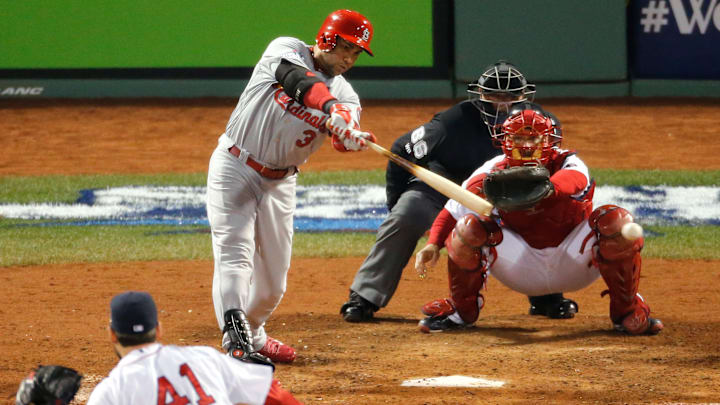John Lackey
Our fourth and final Cardinals Hall of Fame candidate is right-handed pitcher John Lackey. Over his 15-year career, Lackey played for a total of four teams, the first being the Anaheim Angels. Unlike the aforementioned Beltrán, Lackey wouldn’t have to wait long to see playoff success. Debuting in 2002, the 23-year-old right-hander was thrust into the pandemonium of postseason baseball. Despite being only a rookie, Lackey was trusted with starting not one, but two games in the World Series. With the Angels handing him the reigns to start in Game 7, Lackey was making a run to become the first rookie pitcher in 93 years to win the ultimate rubber match. Lackey would go on to pitch five innings in which he only gave up one earned run, allowing his team to run away with their very first World Series championship. To cap off an already incredible year, Lackey also placed fourth in Rookie of the Year Voting, foreshadowing his great career to come.
After a slight regression over the next two years, Lackey quickly bounced back in force, becoming not only a top pitcher for his team but a top pitcher in the entire league. In 2007, Lackey won the ERA Title for the American League, made his first, albeit only All-Star Game, and came 17th in MVP voting.
After another pair of solid performances in 2008 and 2009, Lackey entered free agency as one of the most coveted arms on the market, eventually settling with the Boston Red Sox on a five-year deal.
Things got off to a shaky start, however. Over his first years in Boston, Lackey struggled to the extent that he actually posted a negative bWAR from 2010-2011. He led the league in earned runs and hit-by-pitches in 2011, alongside posting an egregious 6.41 ERA. To make matters even worse, Lackey would need to undergo Tommy John surgery during the offseason, forcing him to miss the entirety of the 2012 campaign. Things weren’t looking good for the then 34-year-old Lackey, but unbeknownst to many, he still had plenty left in the tank.
2013 saw Lackey make an incredible rebound, nearly halving his ERA from 2011 in almost 190 innings on the mound. This comeback coincided with that of the Red Sox, tying the Cardinals for the best record in the league, and eventually defeating them in the World Series having been all the way in last place the prior year. Lackey, who pitched in the series winning Game 6, became the first starting pitcher to ever win two World-Series-clinching games with two separate teams.
Lackey would only spend one more half-season in Boston, after which he was traded to the team he had just played a critical role in defeating the year prior: The St. Louis Cardinals.
Lackey’s talent and skill were on full display coming into 2015 as he took on the role of the Cardinals’ ace. Posting his most strikeouts and innings pitched since 2007, Lackey also established the lowest ERA of his career, a remarkable 2.77. Though he received a mere one point, Lackey nonetheless made an appearance as a Cy Young candidate, coming ninth overall.
Despite winning the NL Central, the Cardinals were faced with their bitter divisional rival heading into the NLDS, the Chicago Cubs. Lackey was given the start in Game 1, and reflective of his regular season performance, he dominated the Cubs, throwing 7.1 innings scoreless. The Cardinals would go on to win Game 1, but things quickly came crashing down when they dropped the next two. To save the Cardinals in a do-or-die Game 4, Lackey was given the start again, but he would wind up imploding in the second inning, surrendering four runs in the second inning, including a disastrous three-run home run to Javier Baez. After tying the game in the sixth inning, the Cardinals would nevertheless lose 6-4.
If losing to the Cubs in the postseason wasn’t bad enough already, the Cardinals would also lose Lackey to them not long after. Signing a two-year, $32 million deal with the Cubbies, this would become Lackey’s final stint in the league. Fortunately for him, though certainly not the Cardinals, it would prove to be a memorable one.
Securing his first career win against the Cardinals on April 18, 2016, Lackey became just the sixteenth pitcher in major league history to win against all 30 major league teams. He finished the year with a 3.35 ERA, and though he wasn’t the top pitcher on his team, he played a major role in helping secure the divisional title. The Cubs weren’t finished, however, and went on to win the World Series in a thrilling showdown against the Cleveland Indians. (Sorry, it’s a critical part of his history. I couldn’t leave it out.)
2017 was the second and final year on Lackey’s contract, seeing him finally experience the regression typical of his age. He surrendered 36 home runs, the most in the league, and finished the year with a 4.59 ERA. Despite being offered a contract in 2018, Lackey opted instead for retirement, ending a true rollercoaster of a career.
Will Lackey Make the Hall of Fame?
Over a career spanning well over a decade, Lackey has put up a number of fantastic seasons, but they were spaced out between periods of inconsistency and struggle. It’s a career worthy of being placed on the Hall of Fame ballot but certainly falls short of actually being worthy of Cooperstown. Simply looking at how people are voting thus far, it’s certainly not looking promising for him. As of the writing of this article, Lackey’s name has been absent from every single submitted ballot, making it unlikely that he’ll make an appearance on next year’s list. As disappointing as that may be, his possession of three World Series rings should certainly lessen the blow.
